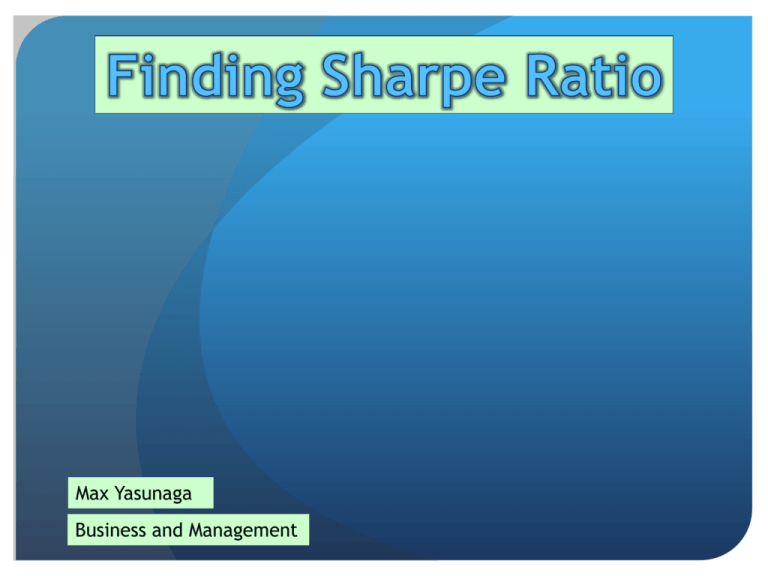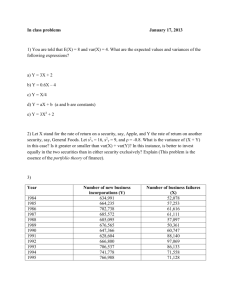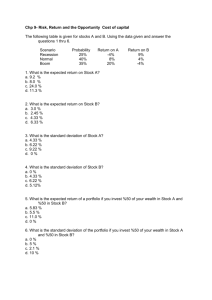Finding Sharpe Ratio
advertisement

Max Yasunaga Business and Management Definition Risk-adjusted measure of return that is used to evaluate the performance of a portfolio. Purpose The idea of the ratio is to see how much additional return an investor receives for the additional unit of volatility compared to a risk-free asset How [Return on portfolio – risk free rate] / Standard Deviation of portfolio Step 1 Retrieve historical prices of the stocks you want to analyze from Yahoo Finance Image 2 Image 1 Image 3 Step 1 Retrieve historical prices of the stocks you want to analyze from Yahoo Finance Step 2 Open the file, and delete the highlighted section, leaving only Adj Close and Date. Rename Goog instead of AdjClose. Sort the dates so that they are ascending and not descending. Image 4 Image 5 Image 6 Image 7 Step 1 Retrieve historical prices of the stocks you want to analyze from Yahoo Finance Step 2 Open the file, and delete the highlighted section, leaving only Adj Close and Date. Rename Goog instead of AdjClose. Sort the dates so that they are ascending and not descending. Step 3 Do the same for all stocks and place the data side by side with GOOG. Image 8 Step 4 Find the average expected rate of return. This can be done by finding all the expected returns and then averaging it. Expected return can be found by taking the difference of the prices and dividing it by the previous price. Example: [(B3-B2)/B2]*100%. Image 9 Image 10 Step 4 Find the average expected rate of return. This can be done by finding all the expected returns and then averaging it. Expected return can be found by taking the difference of the prices and dividing it by the previous price. Example: [(B3-B2)/B2]*100%. Step 5 Below Average Expected Return, find Variance and Standard Deviation. Variance is defined as the average of the squared differences from the Mean and Standard Deviation is the squared root of Variance. Image 11 Image 12 Step 4 Find the average expected rate of return. This can be done by finding all the expected returns and then averaging it. Expected return can be found by taking the difference of the prices and dividing it by the previous price. Example: [(B3-B2)/B2]*100%. Step 5 Below Average Expected Return, find Variance and Standard Deviation. Variance is defined as the average of the squared differences from the Mean and Standard Deviation is the squared root of Variance. Step 6 Build a variance covariance matrix, which finds the total variance of the portfolio Image 13 Image 14 The diagonal values (a1&a1, a2&a2) are found by finding the variance of GOOG and AAPL respectively. The values (a2&a1, a1&a2) are found by taking the covariance of GOOG and AAPL. Step 7 Now lets side step. To the side, do the carry out image 15 Step 8 Now find variance of the portfolio, which will be used to find Sharpe Ratio. Explained in image 16 Image 15 Now type 0.5 and 0.5 next to a1/goog, and a2/aapl. These are the weights. This is where Solver will feed back how we should appropriate our portfolio. And then next to total, type =(highlight cell with 0.5) + (highlight cell with other 0.5). If you are analyzing three stocks, then you will do the same steps we did above, except change the numbers 0.5 & 0.5. Total should always sum up to 1. Image 16 (A) (B) Next to Var port, type =MMULT(TRANSPOSE(…(A)highlight the two 0.5’s in step 15…),MMULT(…(B)highlight everything in the box we made…,…repeat (A) in here…)) Instead of pressing enter, you hold control shift + enter, and you will get the variance of the portfolio. Step 7 Now lets side step. To the side, do the carry out image 15 Step 8 Now find variance of the portfolio, which will be used to find Sharpe Ratio. Explained in image 16 Step 9 Type “Return (port)” all the way to “Sharpe Ratio” as shown in image 17 Step 10 Find Return on Portfolio explained in image 18 Image 17 To find Return on your portfolio, take the expected Rate of Return of stock A for example (which you have found earlier) and multiply the weight distribution to that stock. =weighted average1 * average1 + weighted average2*average2 Image 18 Step 11 Fill in variance of the portfolio, found earlier, and Standard deviation, which is the squared root of the variance. Step 12 Fill in R(port) – rf. Find rf, the yield of a US treasury bond, which we will take as 1/365 (per day). Step 13 Fill in the Sharpe ratio, which is the [R(port)-rf] / SD(port Image 19 Image 20 Image 21 Step 14 Find ultimate weighting by using Solver on excel as shown in image 22. Image 22 Go to tools=> solver, and click on it. Step 14 Find ultimate weighting by using Solver on excel as shown in image 22. Step 15 Fill in parameters as shown in image 23. Image 23 First step is to set the objective. Our objective is maximizing sharpe ratio. So we’ll highlight that cell. Then we have To Max, Min, etc. In this scenario, we want to Maximize, so we choose Max. Image 24 Image 25 Image 26 What are you changing? You’re changing the weight you give to the stock you’re investing in. The amount you invest in the stock. $L$508 is the value of 0.5 next to a1/goog. $L$509 is the value below that. $L$510 is the value of 1. Click solve. And voila! Now try to make the strongest combinations of stocks, and maximize your SHARPE RATIOS





